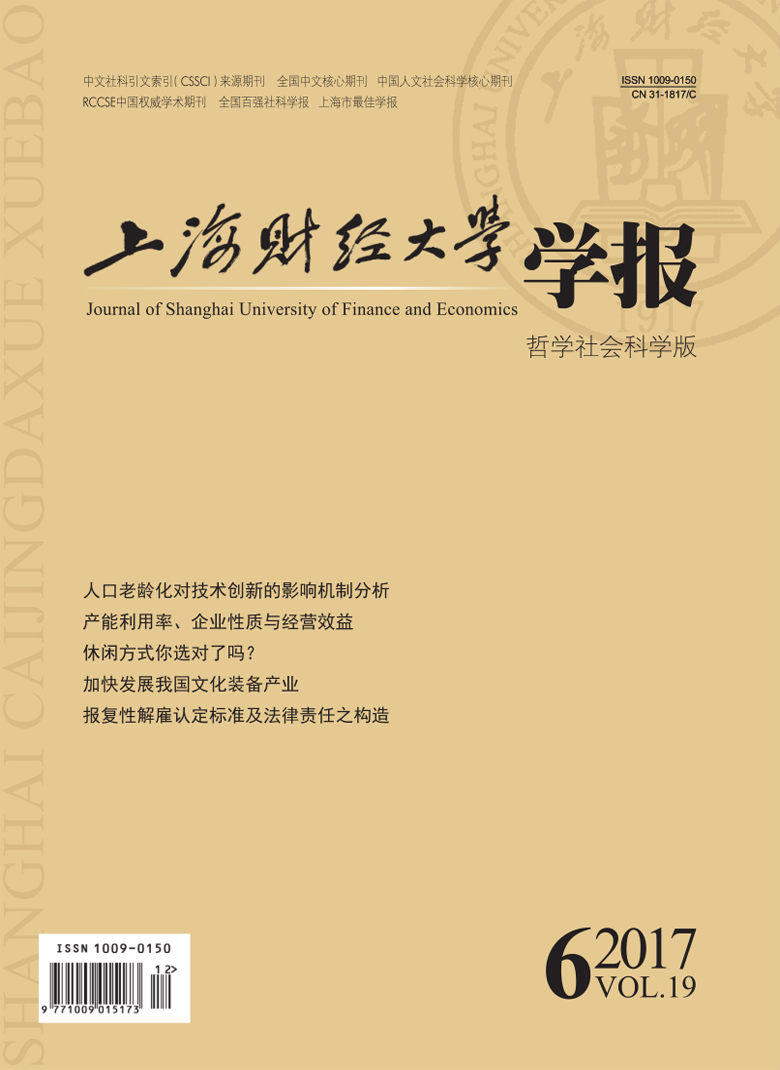In the double background of population aging and China’s economy increasingly driven by technological innovation, the investigation into the effect of population aging on technological innovation is of great importance. This paper evaluates three influence mechanisms of population aging on technological innovation, namely " human capital mechanism”, " labor productivity mechanism” and " the elderly burden mechanism”. Using dynamic factor analysis model, we choose multiple indicators in five aspects-innovation input, innovation output, innovation efficiency, synergy innovation and innovation environment. Then we get a new comprehensive index of technological innovation concerning 29 provinces from 1990 to 2014 and use it as a new indicator of innovation capacity. Using dynamic GMM model, we prove that population aging has two opposite effects on technological innovation: on one hand, population aging has positive effect on technological innovation by improving researchers’ labor efficiency, having the positive " labor productivity effect”; on the other hand, population aging has negative effect on technological innovation by reducing the level of human capital, aggravating the pension burden and squeezing out innovation input, having negative " human capital” and " elderly burden” effects. Our work contributes to the present research by creating a new innovation indicator and analyzing the effect of population aging on technological innovation, and has policy implications for dealing with the challenge of population aging.
 / Journals / Journal of Shanghai University of Finance and Economics
/ Journals / Journal of Shanghai University of Finance and EconomicsJournal of Shanghai University of Finance and Economics
LiuYuanchun, Editor-in-Chief
ZhengChunrong, Vice Executive Editor-in-Chief
GuoChanglin YanJinqiang WangWenbin WuWenfang, Vice Editor-in-Chief
The Influence of Population Aging on Technological Innovation: Based on Innovation Evaluation Using Dynamic Factor Analysis and Dynamic GMM Model
Journal of Shanghai University of Finance and Economics Vol. 19, Issue 06, pp. 4 - 17 (2017) DOI:10.16538/j.cnki.jsufe.2017.06.001
Summary
References
Summary
[1]. Ashworth M J. Preserving knowledge legacies: Workforce aging, turnover and human resource issues in the US electric power industry[J].International Journal of Human Resource Management,2006,17(9):1659-1688.
[2]. Bai J H, Jiang F X. Synergy innovation, spatial correlation and regional innovation performance[J].Economic Research Journal,2015,7:174-187.
[3]. Behaghel L,Greenan N.Training and age-biased technical change[J].Annals of Economics and Statistics,2010,99-100:317-342.
[4]. Chen Z, Lu M, Jin Y. Regional differences of human capitals and education development in China:an estimation of the panel data[J].World Economy,2004,12:25-31.
[5]. Cui M, Wei X J. Productivity change and internal structural heterogeneity in China’s service sub-industry[J].The Journal of Quantitative & Technical Economics,2015,4:3-21.
[6]. Coppi R P R, Zannella F. L’analisi fattoriale di una serie temporale multipla relativa allo stesso insieme di unità statistiche[A]. Proceedings of the XXIX scientific meeting of the Italian statistical society[C].Bologna: Italian Statistical Society,1978.
[7]. Federici A, Mazzitelli A. Dynamic factor analysis with STATA[A].2nd Italian state users Group meeting[C].Milano,2005.
[8]. Feyrer J. Demographics and productivity[R].Dartmouth College Working Paper No. 02-10, 2002.
[9]. Froscb K, Tivig T. Age, human capital and the geography of innovation[A]. Kuhn M, Ochsen C, eds. Labour markets and demographic change[M]. Wiesbaden: VS Verlagfür Sozialwissenschaften, 2009.
[10]. Gonzales-Eiras M, Niepelt D. Aging,government budgets,retirement and growth[J]. European Economic Review, 2012, 56(1): 97-115.
[11]. Habakkuk H J. American and British technology in the nineteenth century: The search for labor-saving inventions[M]. London: Cambridge University Press, 1962.
[12]. Hsu P H, Tian X, Xu Y. Financial development and innovation: cross-country evidence[J]. Journal of Financial Economics,2014,112(1):116-135.
[13]. Hu W L. The relationship between population aging and technology progress[J].The Journal of Quantitative & Technical Economics,1991,11:27-34.
[14]. Ilmakunnas P, Maliranta M. Aging, labor turnover and firm performance[R].ETLA Discussion Papers No. 1092,2007.
[15]. Jia Z L, Lu H Y. Fiscal decentralization and effective supply of education and public goods of the people’s livelihood[J].The Journal of Quantitative & Technical Economics,2010,6:139-150.
[16]. Kuhn M, Hetze P. Team composition and knowledge transfer within an ageing workforce[R]. Rostock Center Discussion Paper, 2007.
[17]. Li G Z, Zhou C Y, Jiang J R. The estimation of regional TFP and its role in China’s regional disparities[J].The Journal of Quantitative & Technical Economics,2010,5:49-61.
[18]. Li S X, Yao D M. Will population aging affect innovation[A]. Ma G Y,eds.Annual Report on China’s Creativity(2012-2013)[C].Beijing: Social Sciences Academic Press,2013.
[19]. Lee R, Mason A. Fertility, human capital, and economic growth over the demographic transition[J]. European Journal of Population,2010,26(2):159-182.
[20]. Noda H. Population aging and creative destruction[J].Journal of Economic Research,2011, 16(1): 29-58.
[21]. Niu Z D, Zhang Q X. An analysis of technological innovation efficiency of manufacturing equipment industries in China[J].The Journal of Quantitative & Technical Economics,2012,11:51-67.
[22]. Romer P M. Crazy explanations for the productivity slowdown[J]. NBER Macroeconomics Annual,1987,2: 163-202.
[23]. Scarth W. Population aging, productivity and living standards [J]. The Review of Economic Performance and Social Progress, 2002, 2: 145-156.
[24]. Tian X Y, Hu W L, Yang Y C. The relationship between population aging and economic progress in Japan-report on survey to Japan[J].Chinese Journal of Population Science,1990,6:59-62.
[25]. Wang W, Jiang Z M.A literature review on the effects of population aging on technological progress[J].Chinese Journal of Population Science,2016,3:114-125.
[26]. Wu X Y. Factor analysis for evaluation of regional technology innovation ability[J].Journal of Harbin Engineering University,2003,2:233-236.
[27]. Wu Y B. R&D stock,knowledge function and productive efficiency[J].China Economic Quarterly,2006,3:1129-1156.
[28]. Yao D M, Ning J, Wei S Y.How does the population aging affect technology innovation?[J].World Economy,2017,4:105-128.
[29]. Zhu P F, Xu W M. On the impact of government’s S&T incentive policy on the R&D input and its patent output of large and medium-sized industrial enterprises in Shanghai[J].Economic Research Journal,2003,6:45-53.
Cite this article
Wang Wei, Jiang Zhenmao. The Influence of Population Aging on Technological Innovation: Based on Innovation Evaluation Using Dynamic Factor Analysis and Dynamic GMM Model[J]. Journal of Shanghai University of Finance and Economics, 2017, 19(6): 4–17.
Export Citations as:
For




 13177
13177  15692
15692

